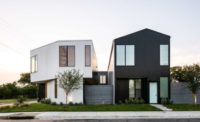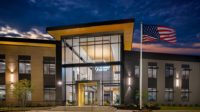With a desire to bring city agencies to a modern centralized location, the City of San Marcos, Texas, constructed nine buildings on a single site. A consistent design element throughout the new Public Service Complex was metal roofing, wall panels and components from MBCI.
“The city wanted to consolidate its public service departments into one complex,” says Edgar Zarate, AIA, Associate at Lawrence Group, Austin, Texas. “Before the project was complete, all the departments were scattered across the city, making it challenging to communicate between departments. This complex will give the city an opportunity to grow in place over the next several years.
“We wanted to provide a flexible office space that provided natural daylighting to all the occupants within a very tight budget. Every building within the complex gives the occupants the ability to see the day shift from morning to evening through the workday.”
Zarate says Lawrence Group and the city had sustainability and resiliency in mind through the design process. Metal is a great sustainable option because of its durability, long life cycle and recyclability. “We integrated a 360 kw-ac solar array, four 18,000-gallon rain collection tanks for irrigation, two 750 eKW, 938 kVA back-up generators with a 2,700-gallon capacity tank per unit, with a third option design for future connection,” he says. “Also, two 1,000-gallon fuel tanks onsite for emergency use. This project was also designed as the emergency operations center in the event of a major catastrophic event.”
Red Dot Buildings of Athens, Texas, a long-time MBCI customer, designed, fabricated and erected the pre-engineered metal buildings and installed the MBCI metal roofing and wall panels. Darrell Geisendorff, regional sales manager for Red Dot, says more than 52,000 square feet of SuperLok® standing seam panels were delivered from the MBCI plant in Houston and installed on the various buildings. The five-section utility building has three workspace areas topped by SuperLok 24-gauge Galvalume Plus panels, connected by two smaller office sections with built-up roofing. A total of 52,428 square feet of MBCI’s PBR roofing panels were installed on parking structures at the complex. The 24-gauge PBR panels used were Galvalume Plus® (49,549 square feet), Slate Gray (42,203 square feet) and Hawaiian Blue (5,204 square feet).
SuperLok is a mechanically seamed vertical leg standing seam roofing system that combines with exceptional wind uplift resistance in a 2-inch slim rib, suitable for attaching solar panels, which this project required.
Other MBCI products installed included 24-gauge Artisan® panels in Galvalume Plus (12,018 square feet), Hawaiian Blue (2,932 square feet) and Polar White (52 square feet); 24-gauge Perforated Artisan® panels in Hawaiian Blue (267 square feet); 24-gauge PBC in Galvalume Plus (34,607 square feet); 24-gauge FW-120 in Galvalume Plus (9,168 square feet), Hawaiian Blue (5,840 square feet) and Slate Gray (2,852 square feet); 24-gauge Masterline® in Charcoal (10,452 square feet); and 24 gauge 7.2 Panel in Hawaiian Blue (358 square feet).
“We were onsite about 10 months,” Geisendorff says. “In light of being a complex design-build, we were able to work together to bring this unique project to the finish line for the customer.”
“The project had a very tight budget and the metal panels helped us achieve the industrial look we wanted for the complex and meet the owner’s budget,” Zarate says. “The MBCI panels provided an industrial look without making the complex look like an average warehouse.”
The utility building is home to a large field of solar panels. The way the utility building was designed, Geisendorff says erecting it required special attention and a lot of communication. Red Dot also installed MBCI wall panels on the administration and crew buildings.
“The utility building has a long floorplan that pivots twice,” he says. “You really have to have an understanding of and pay attention to the frame lines. It was the most complex building on the project. One section was a diverse office space, then you’d walk through a door into a large workspace, then through another door into more office space. It’s a unique building.”







